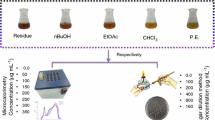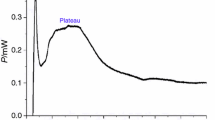Abstract
Fighting against multidrug-resistant bacteria requires reliable methods to evaluate the effect of antibacterial agents. As a universal, non-destructive, and highly sensitive tool, microcalorimetry has been used in many biological investigations to provide continuous real-time monitoring of the metabolic activity. This method, based on heat-flow output, was used to evaluate the influence of two flavonoid compounds (liquiritigenin and liquiritin) on Escherichia coli. Some crucial information, such as the thermogenic power-time curve and thermokinetic parameters of E. coli growth affected by the two compounds, was obtained and further studied by chemometric techniques including similarity analysis, multivariate analysis of variance, and principal component analysis. By comparing the values of two main parameters, k 2 (growth rate constant of the second exponential phase) and Q 1 (heat output of the first exponential growth phase) of E. coli based on the box and whisker plot, liquiritigenin and liquiritin could be differentiated according to their antibacterial effects; liquiritin with IC50 (half-inhibitory concentration) of 198.6 μg mL−1 expressed a stronger antibacterial effect than liquiritigenin with IC50 of 337.8 μg mL−1. The glucoside group in liquiritin containing four additional free hydroxyls in the diphenylpropane skeleton was crucial for inducing the antibacterial effect. Liquiritin might be a promising candidate against E. coli. This study provides a valuable method for searching for novel antibacterial agents using microcalorimetry with chemometrics.






Similar content being viewed by others
References
Alcaráz LE, Blanco SE, Puig ON, Tomás F, Ferretti FH (2000) Antibacterial activity of flavonoids against methicillin-resistant Staphylococcus aureus strains. J Theor Biol 205:231–240
Andrews JM (2001) Determination of minimum inhibitory concentrations. J Antimicrob Chemother 48:5–16
Brahmachari G, Mandal NC, Jash SK, Roy R, Mandal LC, Mukhopadhyay A, Behera B, Majhi S, Mondal A, Gangopadhyay A (2011) Evaluation of the antimicrobial potential of two flavonoids isolated from Limnophila plants. Chem Biodivers 8:1139–1151
Braissant O, Bachmann A, Bonkat G (2015) Microcalorimetric assays for measuring cell growth and metabolic activity: methodology and applications. Methods 76:27–34
Bricheux G, Bonnet JL, Bohatier J, Morel JP, Morel-Desrosiers N (2013) Microcalorimetry: a powerful and original tool for tracking the toxicity of a xenobioticon Tetrahymena pyriformis. Ecotoxicol Environ Saf 98:88–94
Carvalho BMA, Da Silva LHM, Carvalho LM, Soares AM, Minim LA, Da Silva SL (2013) Microcalorimetric study of the adsorption of lactoferrin insupermacroporous continuous cryogel with immobilized Cu2+ ions. J Chromatogr A 1312:1–9
Chen HL, Yao J, Wang F, Zhou Y, Chen K, Zhuang RS, Choi MMF, Zaray G (2010) Toxicity of three phenolic compounds and their mixtures on the Gram-positive bacteria Bacillus subtilis in the aquatic environment. Sci Total Environ 408:1043–1049
Cirak F, Cisternas JE, Cuitiño AM, Ertl G, Holmes P, Kevrekidis IG, Ortiz M, Rotermund HH, Schunack M, Wolff J (2003) Oscillatory thermomechanical instability of an ultrathin catalyst. Science 300:1932–1936
Dastidar SG, Manna A, Kumar KA, Mazumdar K, Dutta NK, Chakrabarty AN, Motohashi N, Shirataki Y (2004) Studies on the antibacterial potentiality of isoflavones. Int J Antimicrob Agents 23:99–102
Ferreira IS, Bettencourt A, Bétrisey B, Gonçalves LMD, Trampuz A, Almeida AJ (2015) Improvement of the antibacterial activity of daptomycin-loaded polymeric microparticles by Eudragit RL 100: an assessment by isothermal microcalorimetry. Int J Pharm 485:171–182
García-Mediavilla V, Crespo I, Collado PS, Esteller A, Sánchez-Campos S, Tuñón MJ, González-Gallego J (2007) The anti-inflammatory flavones quercetin and kaempferol cause inhibition of inducible nitric oxide synthase, cyclooxygenase-2 and reactive C-protein, and down-regulation of the nuclear factor kappa B pathway in Chang liver cells. Eur J Pharmacol 557:221–229
Guo QL, Zhang J, Xu ZQ, Li R, Jiang FL, Xiao Q, Liu Y (2012) Comparative study on the effects of two antifungal drugs against Candida albicans by microcalorimetry and transmission electron microscopy. Thermochim Acta 543:82–87
Hu LP (2001) Practical statistical analysis using Windows SAS 6.12 & 8.0. Military Medical Sciences Press, Beijing
Kong WJ, Wang JB, Xing XY, Jin C, Xiao XH, Zhao YL, Zhang P, Zang QC, Li ZL (2011) Screening for novel antibacterial agents based on the activities of compounds on metabolism of Escherichia coli: a microcalorimetric study. J Hazard Mater 185:346–352
Kong WJ, Wang JB, Xiao XH, Chen SL, Yang MH (2012) Evaluation of antibacterial effect and mode of Coptidis rhizoma by microcalorimetry coupled with chemometric techniques. Analyst 137:216–222
Lai L, Lin C, Xiao CQ, Xu ZQ, Han XL, Fu L, Li DW, Mei P, Jiang FL, Guo QL, Liu Y (2013) Adhesion of quantum dots-induced membrane damage of Escherichia coli. J Colloid Interface Sci 389:61–70
Li XY, Wang J, Dong HZ, Zhang HL (2014) Kinetic study of α-amylase in the process of starch hydrolysis by microcalorimetry. Thermochim Acta 579:70–73
Liu IX, Durham DG, Richards RME (2000) Baicalin synergy with beta-lactam antibiotics against methicillin-resistant Staphylococcus aureus and other beta-lactam-resistant strains of S. aureus. J Pharm Pharmacol 52:361–366
Ohemeng KA, Schwender CF, Fu KP, Barrett JF (1993) DNA gyrase inhibitory and antibacterial activity of some flavones (1). Bioorg Med Chem Lett 3:225–230
Plaper A, Golob M, Hafner I, Oblak M, Solmajer T, Jerala R (2003) Characterization of quercetin binding site on DNA gyrase. Biochem Biophys Res Commun 306:530–536
Sarpietro MG, Ottimo S, Giuffrida MC, Micieli D, Castelli F (2009) Calorimetric evaluation of the interaction and absorption of eicosapentaenoic acid by biomembrane models. Thermochim Acta 495:149–154
Sato M, Tsuchiya H, Akagiri M, Takagi N, Iinuma M (1997) Growth inhibition of oral bacteria related to denture stomatitis by anticandidal chalcones. Aust Dent J 42:343–346
Silva MAVR, Santos LMNBF, Lima LMSS (2010) Thermodynamic study of 1,2,3-triphenylbenzene and 1,3,5-triphenylbenzene. J Chem Thermodyn 42:134–139
Spooner FD, Sykes G, Norris JR, Ribbons DW (1972) Methods in microbiology, Vol. 7B. Academic Press, London
Tim Cushnie TP, Lamb AJ (2005) Antimicrobial activity of flavonoids. Int J Antimicrob Agents 26:343–356
Ulanowska K, Tkaczyk A, Konopa G, Węgrzyn G (2006) Differential antibacterial activity of genistein arising from global inhibition of DNA, RNA and protein synthesis in some bacterial strains. Arch Microbiol 184:271–278
Wadsö I (2002) Isothermal microcalorimetry in applied biology. Thermochim Acta 394:305–311
Wu T, He MY, Zang XX, Zhou Y, Qiu TF, Pan SY, Xu XY (2013) A structure- activity relationship study of flavonoids as inhibitors of E. coli by membrane interaction effect. Biochim Biophys Acta 1828:2751–2576
Xiao Q, Huang S, Su W, Li PY, Liu Y (2013) Evaluate the potential toxicity of quantum dots on bacterial metabolism by microcalorimetry. Thermochim Acta 552:98–105
Xie CL, Tang HK, Song ZH, Qu SS (1988) Microcalorimetric study of bacterial growth. Thermochim Acta 123:33–41
Zhang T, Li X, Min XM, Fang TT, Zhang ZJ, Yang L, Liu P (2012) Acute toxicity of chlorobenzenes in Tetrahymena: estimated by microcalorimetry and mechanism. Environ Toxicol Pharmacol 33:377–385
Zhang T, Li X, Lu Y, Liu P, Zhang CC, Luo H (2014) Joint toxicity of heavy metals and chlorobenzenes to pyriformis Tetrahymena. Chemosphere 104:177–183
Zhong JQ, Li B, Jia Q, Li YM, Zhu WL, Chen KX (2011) Advances in the structure-activity relationship study of natural flavonoids and its derivatives. Acta Pharm Sin 46:622–630
Acknowledgments
The authors are grateful for the support from the National Science Foundation of China (81473346, 81274072) and Xihe New Star Project.
Conflict of interest
The authors declare that they have no competing interests.
Author information
Authors and Affiliations
Corresponding authors
Rights and permissions
About this article
Cite this article
Kong, W., Zhao, Y., Xing, X. et al. Antibacterial evaluation of flavonoid compounds against E. coli by microcalorimetry and chemometrics. Appl Microbiol Biotechnol 99, 6049–6058 (2015). https://doi.org/10.1007/s00253-015-6711-1
Received:
Revised:
Accepted:
Published:
Issue Date:
DOI: https://doi.org/10.1007/s00253-015-6711-1




